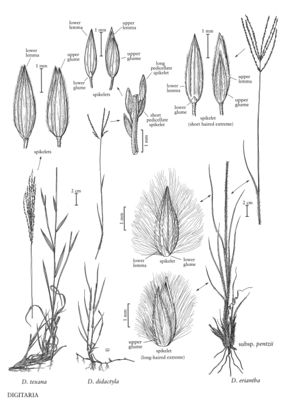Digitaria didactyla
Plants perennial; stoloniferous and rhizomatous, mat-forming. Culms 15-40(63) cm, rooting and branching from the lower nodes. Sheaths densely to sparsely hairy, with 3-5 mm papillose-based hairs; ligules 1-1.5 mm; blades 2.5-7 cm long, 1-3 mm wide, flat or folded, usually glabrous, green to bluish-green. Panicles with 2-4 spikelike primary branches digitately arranged; primary branches 2-7 cm, axes wing-margined, wings at least 1/2 as wide as the midribs, spikelets somewhat imbricate, in unequally pedicellate pairs; secondary branches rarely present; pedicels not adnate to the branches; shorter pedicels 1-1.5 mm; longer pedicels 2-3 mm; axillary panicles not present. Spikelets homomorphic, 2-2.8 mm long, about 0.8 mm wide. Lower glumes to 0.3 mm, triangular; upper glumes from 1/2 - 3/4 as long as the spikelets, 3-veined, pilose on the margins and sometimes between the veins; upper lemmas equaling the spikelets, prominently 7-veined, veins equally spaced, margins and sometimes the intercostal regions pilose, hairs 0.3-0.5 mm; upper lemmas slightly shorter than the lower lemmas, almost smooth, gray, sometimes purple-tinged, at maturity. 2n = unknown.
Discussion
A native of Africa, Digitaria didactyla is often cultivated as a lawn grass in tropical and subtropical regions. It has been grown experimentally in Florida, but is not otherwise known from the Flora region.
Selected References
None.
